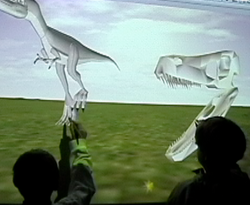This article needs to be updated.(November 2022) |
| Edusim | |
|---|---|
 | |
| Initial release | September 2007 |
| Written in | Squeak |
| Engine | Cobalt |
| Operating system | Windows, macOS, Linux |
| Available in | English |
| Type | Virtual world interactive whiteboard |
| License | code: MIT media: at least mostly CC BY-SA-NC |
| Website | edusim3d |

Edusim is a cave automatic virtual environment "Immersive Touch" 3D natural user interface (NUI)-based concept of lesson driven (multi-user) 3D virtual worlds on the classroom interactive whiteboard or classroom interactive surface. The Edusim concept is demonstrated by the Edusim free and open-source multi-user 3D Open Cobalt virtual world platform and authoring tool kit modified for the classroom interactive whiteboard or surface. The Edusim application is a modified edition of the open source Open Cobalt Project and relies heavily on the affordances of direct manipulation of 3D virtual learning models and constructionist learning principles.